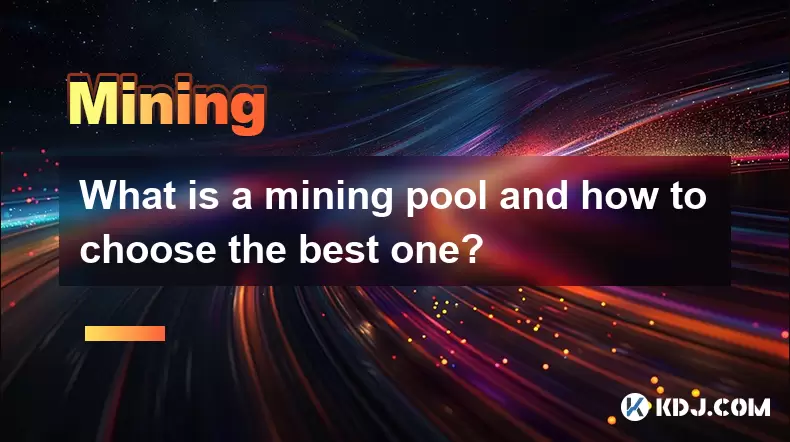-
 bitcoin
bitcoin $120167.907534 USD
1.27% -
 ethereum
ethereum $4468.611945 USD
2.53% -
 xrp
xrp $3.013607 USD
1.80% -
 tether
tether $1.000549 USD
-0.01% -
 bnb
bnb $1092.592149 USD
6.28% -
 solana
solana $231.391244 USD
4.59% -
 usd-coin
usd-coin $0.999699 USD
-0.04% -
 dogecoin
dogecoin $0.259020 USD
4.30% -
 tron
tron $0.342747 USD
0.34% -
 cardano
cardano $0.860977 USD
1.07% -
 hyperliquid
hyperliquid $50.155412 USD
5.34% -
 chainlink
chainlink $22.637678 USD
0.46% -
 ethena-usde
ethena-usde $1.000528 USD
-0.07% -
 avalanche
avalanche $30.613779 USD
-0.07% -
 stellar
stellar $0.403905 USD
0.94%
What is a mining pool and how to choose the best one?
A mining pool combines miners' computing power to boost block discovery chances, offering more consistent rewards based on contributed hashrate.
Aug 11, 2025 at 06:22 pm

Understanding the Concept of a Mining Pool
A mining pool is a collective group of cryptocurrency miners who combine their computational power to increase the likelihood of successfully mining a block on a blockchain network. In decentralized systems like Bitcoin or Litecoin, mining involves solving complex cryptographic puzzles to validate transactions and add new blocks to the chain. The reward for mining a block is typically a fixed amount of cryptocurrency. However, due to the increasing difficulty and competition, individual miners often struggle to mine blocks alone. By joining a mining pool, participants share their processing power and, in return, receive a portion of the block reward proportional to their contributed work.
When a mining pool successfully mines a block, the reward is distributed among participants based on their hashrate contribution. This model ensures more consistent and predictable earnings compared to solo mining, where rewards can be infrequent and highly uncertain. Mining pools operate using specialized software that coordinates the distribution of work and tracks each miner’s share. Common pool reward systems include Pay-per-Share (PPS), Proportional, and PPLNS (Pay Per Last N Shares), each with distinct payout mechanisms and risk profiles.
Key Factors to Consider When Choosing a Mining Pool
Selecting the right mining pool requires evaluating several critical aspects to ensure reliability, profitability, and compatibility with your mining setup. One of the most important considerations is the pool’s hashrate percentage relative to the total network. A pool controlling more than 30% of the network's hashrate raises centralization concerns, potentially threatening the decentralization principle of blockchain. Therefore, opting for a pool with a moderate hashrate share (between 5% and 20%) is often recommended.
Another vital factor is the fee structure. Most pools charge a maintenance fee, typically ranging from 1% to 3% of the block reward. Lower fees can increase net earnings, but they should not be the sole deciding factor. Some pools offer zero-fee models but compensate through reduced payout thresholds or alternative revenue streams. Transparency in fee calculation is essential.
The payout method directly impacts income stability. For example, PPS offers fixed payments per share, reducing variance but often including higher fees. PPLNS pays based on recent contributions, favoring consistent miners but introducing income fluctuations. Understanding how each method aligns with your mining duration and risk tolerance is crucial.
Technical Requirements and Compatibility
Before joining a mining pool, verify that your mining hardware and software are compatible. Most pools support standard protocols such as Stratum or GetBlockTemplate (GBT). You must configure your mining software—such as CGMiner, BFGMiner, or EasyMiner—to connect to the pool’s server using the correct stratum URL, port number, and worker credentials.
To set up your connection:
- Obtain your worker details from the pool’s dashboard
- Enter the pool address (e.g., stratum+tcp://pool.example.com:3333)
- Input your username (often in the format pool_username.worker_name)
- Provide your password, which may be set to “x” or left blank depending on the pool
- Save the configuration and launch the miner
Ensure your internet connection is stable, as frequent disconnects can reduce your accepted shares and earnings. Some pools offer failover servers to maintain uptime during outages—configure these as backup endpoints in your miner settings.
Security and Trustworthiness of Mining Pools
Security is a major concern when entrusting a pool with your mining rewards. Always choose pools with a proven track record and transparent operations. Look for pools that publish real-time statistics, including hashrate, active miners, and recent blocks mined. Reputable pools often provide SSL/TLS encryption for data transmission, protecting your login and mining data from interception.
Avoid pools that require excessive personal information or lack clear contact details. Community feedback on forums like Bitcointalk or Reddit’s r/CryptoCurrency can reveal patterns of late payouts or disputed rewards. Additionally, pools that open-source their backend code or allow public audits demonstrate higher accountability.
Check whether the pool supports two-factor authentication (2FA) for account access. This adds a layer of protection against unauthorized logins. Also, confirm the minimum payout threshold—some pools set it too high, delaying your ability to withdraw earnings. A reasonable threshold balances operational costs with user convenience.
Top Mining Pools for Major Cryptocurrencies
Different cryptocurrencies have dominant mining pools based on network distribution and performance. For Bitcoin (BTC), notable pools include F2Pool, Antpool, and Foundry USA. These pools collectively control a significant portion of the Bitcoin network but remain within acceptable decentralization limits when used in combination.
For Litecoin (LTC), F2Pool and Viabtc are widely used due to their stable uptime and efficient payout systems. Ethereum, although transitioning away from proof-of-work, previously relied on pools like Ethermine and 2Miners, which now support Ethereum Classic (ETC) and other forked chains.
When mining Bitcoin Cash (BCH) or Bitcoin SV (BSV), consider Binance Pool or Slush Pool, both known for transparent operations and low fees. Always verify the current hashrate distribution on sites like Blockchain.com or PoolWatch before committing.
Frequently Asked Questions
Can I switch mining pools without losing my hardware investment?Yes, switching pools does not affect your mining hardware. You only need to reconfigure your mining software with the new pool’s connection details. Your ASIC or GPU remains fully functional and can connect to any compatible pool.
How are mining rewards calculated within a pool?Rewards are calculated based on the number of valid shares you submit relative to the total shares submitted by all miners. Each share represents a unit of work. The pool tracks your contribution and distributes rewards accordingly when a block is found.
What happens if the mining pool goes offline?If the main server goes down, your miner will stop receiving work assignments, halting earnings. To mitigate this, configure multiple server addresses (primary and backup) in your mining software. Some pools automatically redirect traffic to mirrors during outages.
Is it possible to mine for multiple pools simultaneously?While technically feasible by running separate mining instances, it is inefficient. Mining software typically connects to one pool at a time. Splitting your hashrate across pools reduces your contribution to each, potentially lowering reward eligibility and increasing configuration complexity.
Disclaimer:info@kdj.com
The information provided is not trading advice. kdj.com does not assume any responsibility for any investments made based on the information provided in this article. Cryptocurrencies are highly volatile and it is highly recommended that you invest with caution after thorough research!
If you believe that the content used on this website infringes your copyright, please contact us immediately (info@kdj.com) and we will delete it promptly.
- BlockDAG, DOGE, HYPE Sponsorship: Crypto Trends Shaping 2025
- 2025-10-01 00:25:13
- Deutsche Börse and Circle: A StableCoin Adoption Powerhouse in Europe
- 2025-10-01 00:25:13
- BlockDAG's Presale Buzz: Is It the Crypto to Watch in October 2025?
- 2025-10-01 00:30:13
- Bitcoin, Crypto, and IQ: When Genius Meets Digital Gold?
- 2025-10-01 00:30:13
- Stablecoins, American Innovation, and Wallet Tokens: The Next Frontier
- 2025-10-01 00:35:12
- NBU, Coins, and Crypto in Ukraine: A New Yorker's Take
- 2025-10-01 00:45:14
Related knowledge

The difference between staking and mining
Sep 24,2025 at 05:18am
Understanding Staking in the Cryptocurrency Ecosystem1. Staking involves holding funds in a cryptocurrency wallet to support the operations of a block...

How to participate in testnet mining?
Sep 22,2025 at 09:18am
Understanding Testnet Mining in the Crypto Ecosystem1. Testnet mining is a method used by blockchain developers to simulate real-world conditions on a...

How to dispose of abandoned mining machines?
Sep 19,2025 at 08:19pm
Assessing the Condition of Abandoned Mining Rigs1. Begin by inspecting each mining machine for visible damage, corrosion, or missing components. Machi...

How to identify high-quality mining pools?
Sep 21,2025 at 03:19pm
Reputation and Track Record1. A mining pool’s reputation is built over time through consistent performance and transparency. Pools that have operated ...

Advantages of decentralized mining pools
Sep 20,2025 at 04:36pm
Enhanced Security and Resistance to Censorship1. Decentralized mining pools operate on blockchain-based smart contracts, eliminating the need for a ce...

What is mining machine overclocking?
Sep 21,2025 at 07:19pm
Understanding Mining Machine Overclocking1. Mining machine overclocking refers to the process of increasing the operating frequency of a cryptocurrenc...

The difference between staking and mining
Sep 24,2025 at 05:18am
Understanding Staking in the Cryptocurrency Ecosystem1. Staking involves holding funds in a cryptocurrency wallet to support the operations of a block...

How to participate in testnet mining?
Sep 22,2025 at 09:18am
Understanding Testnet Mining in the Crypto Ecosystem1. Testnet mining is a method used by blockchain developers to simulate real-world conditions on a...

How to dispose of abandoned mining machines?
Sep 19,2025 at 08:19pm
Assessing the Condition of Abandoned Mining Rigs1. Begin by inspecting each mining machine for visible damage, corrosion, or missing components. Machi...

How to identify high-quality mining pools?
Sep 21,2025 at 03:19pm
Reputation and Track Record1. A mining pool’s reputation is built over time through consistent performance and transparency. Pools that have operated ...

Advantages of decentralized mining pools
Sep 20,2025 at 04:36pm
Enhanced Security and Resistance to Censorship1. Decentralized mining pools operate on blockchain-based smart contracts, eliminating the need for a ce...

What is mining machine overclocking?
Sep 21,2025 at 07:19pm
Understanding Mining Machine Overclocking1. Mining machine overclocking refers to the process of increasing the operating frequency of a cryptocurrenc...
See all articles










































































